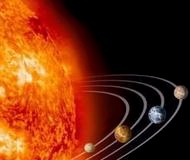
| The full report in a single page | ||
| Contents | Prev | Next |
![]()
10. Expansion in All Inner Planets
All inner planets have lowlands and highlands. All lowlands on all of the planets are made of molten basalt rocks, and they are younger than the highlands.. The oceanic crust is the lowland of Earth.
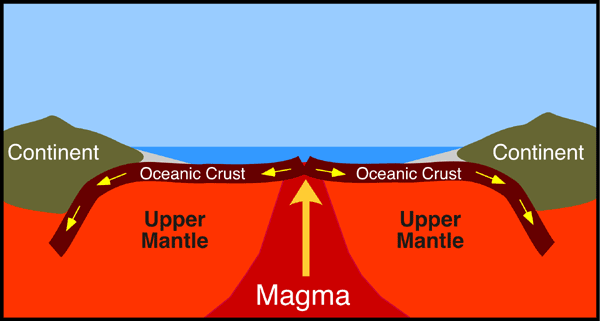
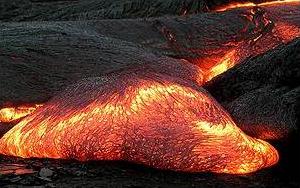
At the time when the rocks were falling from the sky, they fell either in trenches to build mountains, or go directly to the Earth's mantle, to be reproduced to make the ocean floor. The reason for the rocks to target these places is their high magnetic field. The magnetic field was created by moving ionized gases; the ionization of gases was created by gamma rays from the dying second sun.
QUOTE: "Motion of an ionized gas will produce a magnetic field."
http://stars.astro.illinois.edu/...
Since the falling rocks contain iron and magnetism, they were attracted to the nearest magnetic field.
However, the falling rocks are not breaking, they fall in slow motion, because the gravity of Earth at that time was much weaker than it is now.
Cracked Surface, Faults -- a countless number of cracks have taken place all over this new solid layer. These cracks are the same as the ones that are called 'Faults' by the tectonic theory. The exact number of cracks is unknown, and the way they were created is random.
Any solid and closed container is subject to cracks due to temperature changes. Temperatures inside the mantle are much higher than temperatures above the crust. The result is cracks everywhere. Some are short cracks, and some others are long. Cracks are a must for the mantle to breath.
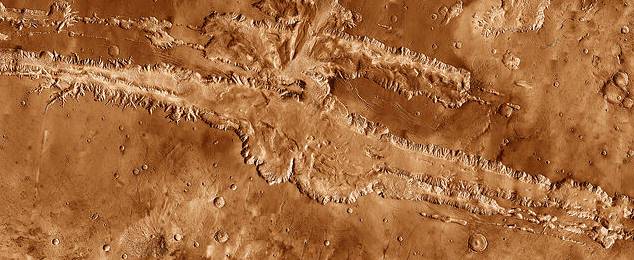
A long crack on the surface of Mars, over 4,000 km
"It has been recently suggested that Valles Marineris is
a large tectonic 'crack' in the Martian crust."
https://en.wikipedia.org/...
They think that Mars had tectonic activities! It never had any similar to Earth. Only little movements when the planet expanded and the new solid layer was built, plus cracks for the mantle to breath.
Mercury, the moon, Venus and Mars, plus the planets of the second sun, all of them must have cracks on their surfaces, because all of them have expanded. Cracks on Mercury, the moon, and Mars have been discovered, but not on the other planets.
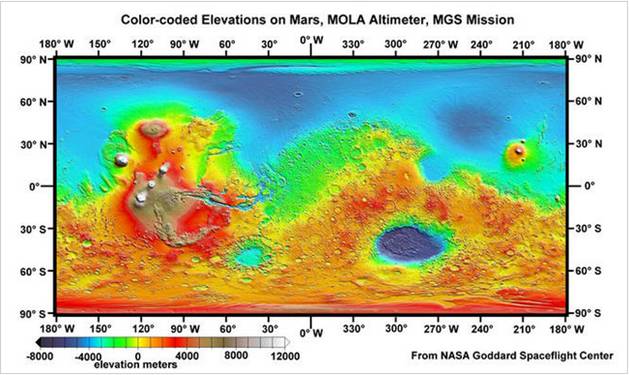
The above map of Mars shows some of the planet's lowlands and highlands. You can see on the scale below the map that the lowlands are lower up to 8km (-8000 meters on the scale). Like the seafloor on Earth, the lowlands on Mars are made mainly of molten basalt rocks.
It can also be seen on the map above that the number of impact craters on the lowlands is much less than the highlands. This is a clear indication that the lowlands are much younger than the highlands.
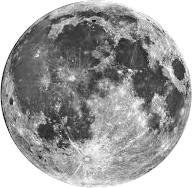
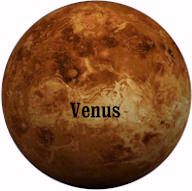
Some ancient cultures called the dark areas on the moon "seas," assuming there is water on the moon. This assumption is proven incorrect, and there are no seas on the moon. However, these dark areas are still called lunar maria. In Latin, maria is the plural of mare, and means seas.
These dark areas on the moon are not at the same level as the so-called highlands. And just like the seafloor on Earth, and the lowlands on Mars, the moon's lowlands are also made of molten basalt rock!
Venus is very close to the sun, the temperature there is very high, about 460°C, and its atmosphere is very thick, so that the surface of the planet cannot be seen. However, radar images show that Venus has lowlands and highlands. About 80% of Venus is lowland.
"It is hypothesized that Venus underwent some sort of
global resurfacing about
300–500 million years ago, though no Venusian rock has ever been dated.
One possible explanation for this event is that it is part of a cyclic process
on Venus. On Earth, plate tectonics allows heat to escape from the mantle.
However, Venus has no evidence of plate tectonics, so this theory states that
the interior of the planet heats up (due to the decay of radioactive elements)
until material in the mantle is hot enough to force its way to the surface."
http://en.wikipedia.org/...
Because the lowlands on Venus are much younger than the highlands, they have been dated between 300 and 500 million years. But this is just an assumption. Those who have given this date, they could easily date them 200 – 300 million years, as old as the sea floor on Earth.
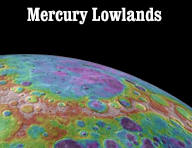
Mercury is the closest planet to the sun. Its size is about the size of the
moon. And just like the other inner planets, it does have lowlands and
highlands. Visually the lowlands on Mercury appear much younger in age than the
highlands.
The only difference between the Earth's lowlands and the lowlands on the other
inner planets is that the lowlands on Earth are filled with water, oceans,
whereas the others are still empty.
The age of the seafloor on Earth is estimated to be about 200 million years old, compared to the earth's highland which is about 4.6 billion years old. The given explanation is that the seafloor is being recycled every 200 million years.
The explanation for the lowlands on the moon, as well as Mercury, is that impacts of heavy meteorites have pushed the crust down, and then lava flowed on these lowered surfaces. But the source of the supposed lava flow on these surfaces hasn't been found yet! No traces of any large volcanoes are found anywhere on the moon that can produce such large areas of lowlands.
Unlike the moon and Mercury, Venus does not have large impact craters on its surface, nor has oceans and tectonic activities to "recycle" the seafloor every 200 million years, but it does have lowlands and highlands!
The estimated age of the lowlands on the moon is about 3.5 "billion" years, whereas the highlands, like the earth, is about 4.6 billion years. However, this age estimate seems very much exaggerated.
It seems that those who have done the radiometric test on some of the moon's rocks have ruled out rocks with small numbers of years, in one way or another, and tried to push the date back as much as possible, so that the numbers appear reasonable to them.
 Another
technique of estimating the age of a surface is by counting the impact craters
on the surface; the greater the crater density, the older the terrain. The
crater counting technique gives the lowlands of the moon a very different age:
Another
technique of estimating the age of a surface is by counting the impact craters
on the surface; the greater the crater density, the older the terrain. The
crater counting technique gives the lowlands of the moon a very different age:
"Lunar maria (lowlands) have only 1/20 the crater
density of the lunar highlands, therefore, they should be 1/20 the age, right?
So, by this reasoning, if the highlands were 4.5 billion years old, as old as
the Earth, then the maria would be just 200 million years old."
http://www.coursehero.com/...
As you can see in the quote above, the crater counting technique gives the lowlands of the moon an age of about 200 million years only, as old as the ocean floor on earth!
Visually the moon's lowlands look much younger than the highlands. So something must have gone wrong with the radiometric dating technique to give very old ages for areas that look very, very new.
![]()
| The full report in a single page | ||
| Contents | Prev | Next |
